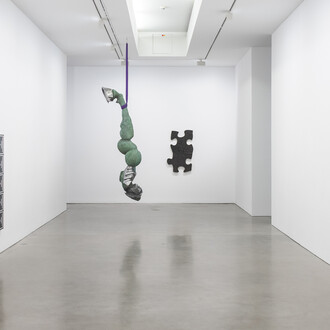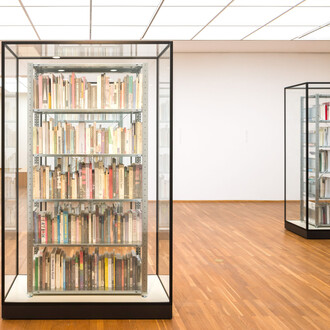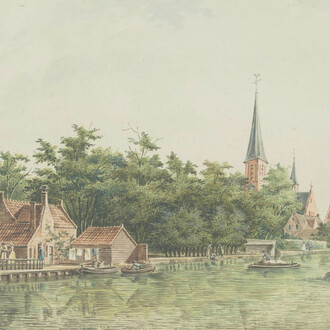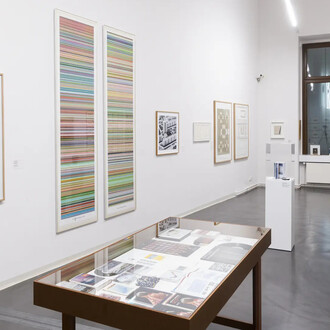For the inaugural show in the new space at Mercator Höfe on Potsdamer Straße, Galerie Thomas Schulte presents a solo exhibition of recent paintings and drawings by Cosima zu Knyphausen. Through varied techniques, formats and materials, zu Knyphausen draws on sources from the art historical, literary and pop cultural to the everyday, personal and self-referential. The works brought together here under the title of Maestra trace fragmentary paths to learning and discovery across different realms of education and desire. What opens up is a layered reflection: on historical representations of women, as artists and in art; and the vocation of artist, its current models and canons, through the lens of her own artistic training and practice.
Whether contoured in loosely sketched, yet bold lines or taking shape through blurred atmospheres of vibrant colors in diffuse strokes, zu Knyphausen’s works invite us to draw close, as though peering into a book. In scenes frequently set in interiors, this impression is amplified by depictions and enactments of contemplation, analysis, reading, interpretation and reinterpretation.
A drawing offering a prelude, an invitation to the exhibition – which fittingly takes place down the street from the former site of a historic painting school for female artists1 – depicts the allegorical Elements of art: design, composition, coloring and invention. Here, zu Knyphausen looks to the motif realized in the room-framing ceiling paintings of Angelika Kauffmann from 1778-80, whichnotably featuredfemale figures in all four images. As representations of intellectual and creative activity considered fundamental to art, they also reflect the disciplinary pillars through which systems of organizing and categorizing it have been upheld. This referential quality, evident not only in the quoting of another artist, but also in the portrayal of the artistic process itself, is a thread that runs through. Titles of works like Ibídem (2023) and La source (2024) – both of which show women in intimate pairings or groups as they pore over books or images together – even call on systems of citation embedded in the material of study. These, in turn, point to a certain place: to a beginning.
Among recurrent subjects like the artist’s studio or the revisiting of works by historical figures like Artemisia Gentileschi, there are allusions to zu Knyphausen’s own education – a kind of beginning: from attending an all-girls Catholic school to studying painting at art school. The latter at times appears in lighthearted, discrete references to the scathing mark left by an authoritarian professor. The figure of the professor is present and repeated in different works – In Boden der HGB (dreckig) (2022/23), for example, she stands at the end of a corridor facing a window, almost a shadow. What gives definition to the scene, however, is the black-and-white tiling of the art school’s floor. A moment framed by place, the pattern is not only reproduced in the small image at the center of the canvas, but is also blown up around it, extending to its edges. It could continue on, or perhaps open up to reveal something else entirely.
Such works – in which an image substantially smaller than the canvas is framed by, or layered with, an abstract pattern – often recall medieval miniatures and motifs. While the image fills more of the surface in other paintings, it is at times also vividly outlined, or contained within a rough oval, like a thought bubble illustrating a daydream. And still others comprise multiple scenes placed side by side, or stacked on top of one another, similar to a comic strip. Throughout, presented as vignettes, their pictorial framing is clear.
Further themes related to role models, complicity, and lesbian desire crop up. From snippets of a music video by t.A.T.u (All the things she said from 2002), framed by the motif of a chain-link fence; to a playful inversion of Death and the maiden (2024), in which a naked figure stands confidently before a bed, presenting herself to the reclining skeleton of a lover; or a hazy scene in the interior of Möbel Olfe, a beloved queer bar in Berlin. Individual moments big and small, profound and mundane, fictional and real, across time and space, here occupy the same plane.
This fragmentary, patchwork approach is also reflected in zu Knyphausen’s use of materials that have been left over or produced through her time and work in the studio. These include more explicit references to painting production, such as strips of canvas and used staples, as well as more metaphorical ones, like egg shells. How difficult can it be (2024),for example,comprises a spattering of loosened staples on a dark teal background with a rugged piece of canvas applied to the center. In it, a small image in succinct black outlines shows an artist engaged in building a stretcher frame. While the egg shells similarly lend themselves to textured surfaces, they are also used for more elaborate, irregular patterns of tiling, like mosaics. In Egg mosaic VI (2024), the broken shells are assembled, from randomness, into a specific grid: a chessboard. Left open and blank, it holds the potential for actions both planned and unpredictable. It offers a framework: for the configuration of different parts, rules, roles, strategies and relations; for a kind of world-building.
In Maestra, we are invited to contemplate our notions of trajectories to be followed, sets of rules to be mastered, and what is taught, learned, and often left out of such structures. More than an attempt to accumulate knowledge, achievements, or recognition; through continuous repetitions, reworkings and reimaginings, it is the desire to understand, (un)learn, create and transform, that is conveyed. A desire to seek out new narratives and representational possibilities, to pick up the pieces and build the frame anew.
(Text by Julianne Cordray)
Notes
1 Founded in the late 19th century, the first painting school to offer training to female artists in Germany, before they were allowed to study in art academies, was located at Potsdamer Straße 98.
















